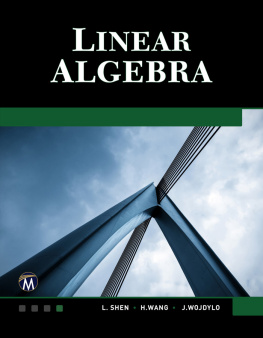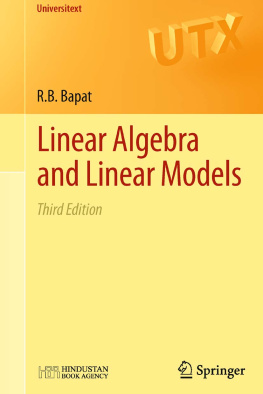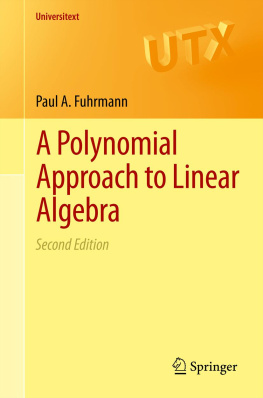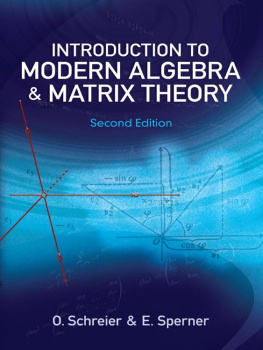
Table of Contents
List of Illustrations
- Chapter 1
- Chapter 2
- Chapter 3
- Chapter 4
- Chapter 5
- Chapter 6
- Chapter 7
Guide
Pages
Linear Algebra
Michael L. OLeary

This edition first published 2021
2021 John Wiley and Sons, Inc.
All rights reserved. No part of this publication may be reproduced, stored in a retrieval system, or transmitted, in any form or by any means, electronic, mechanical, photocopying, recording or otherwise, except as permitted by law. Advice on how to obtain permission to reuse material from this title is available at http://www.wiley.com/go/permissions.
The right of Michael L. OLeary to be identified as the author of this work has been asserted in accordance with law.
Registered Office
John Wiley & Sons, Inc., 111 River Street, Hoboken, NJ 07030, USA
Editorial Office
111 River Street, Hoboken, NJ 07030, USA
For details of our global editorial offices, customer services, and more information about Wiley products visit us at www.wiley.com.
Wiley also publishes its books in a variety of electronic formats and by printondemand. Some content that appears in standard print versions of this book may not be available in other formats.
Limit of Liability/Disclaimer of Warranty
The contents of this work are intended to further general scientific research, understanding, and discussion only and are not intended and should not be relied upon as recommending or promoting scientific method, diagnosis, or treatment by physicians for any particular patient. In view of ongoing research, equipment modifications, changes in governmental regulations, and the constant flow of information relating to the use of medicines, equipment, and devices, the reader is urged to review and evaluate the information provided in the package insert or instructions for each medicine, equipment, or device for, among other things, any changes in the instructions or indication of usage and for added warnings and precautions. While the publisher and authors have used their best efforts in preparing this work, they make no representations or warranties with respect to the accuracy or completeness of the contents of this work and specifically disclaim all warranties, including without limitation any implied warranties of merchantability or fitness for a particular purpose. No warranty may be created or extended by sales representatives, written sales materials or promotional statements for this work. The fact that an organization, website, or product is referred to in this work as a citation and/or potential source of further information does not mean that the publisher and authors endorse the information or services the organization, website, or product may provide or recommendations it may make. This work is sold with the understanding that the publisher is not engaged in rendering professional services. The advice and strategies contained herein may not be suitable for your situation. You should consult with a specialist where appropriate. Further, readers should be aware that websites listed in this work may have changed or disappeared between when this work was written and when it is read. Neither the publisher nor authors shall be liable for any loss of profit or any other commercial damages, including but not limited to special, incidental, consequential, or other damages.
Library of Congress CataloginginPublication Data
Names: OLeary, Michael L., author.
Title: Linear algebra / Michael L. OLeary.
Description: Hoboken, NJ : Wiley, 2021. | Includes bibliographical references and index.
Identifiers: LCCN 2021008522 (print) | LCCN 2021008523 (ebook) | ISBN 9781119437444 (hardback) | ISBN 9781119437475 (adobe pdf) | ISBN 9781119437604 (epub) | ISBN 9781119437437 (obook)
Subjects: LCSH: Algebras, Linear.
Classification: LCC QA184 .O425 2021 (print) | LCC QA184 (ebook) | DDC 512/.5-dc23
LC record available at https://lccn.loc.gov/2021008522
LC ebook record available at https://lccn.loc.gov/2021008523
Cover design by Wiley
Cover image: Hank Erdmann/Shutterstock
For my niece, Lindsay
Preface
This book is an introduction to linear algebra. Its goal is to develop the standard first topics of the subject. Although there are many computations in the sections, which is expected, the focus is on proving the results and learning how to do this. For this reason, the book starts with a chapter dedicated to basic logic, set theory, and proofwriting. Although linear algebra has many important applications ranging from electrical circuitry and quantum mechanics to cryptography and computer gaming, these topics will need to wait for another day. The goal here is to master the mathematics so that one is ready for a second course in the subject, either abstract or applied. This may go against current trends in mathematics education, but if any mathematical subject can stand onits own and be learned for its own sake, it is the amazing and beautiful linear algebra.
In addition to the focus on proofs, linear transformations play a central role. For this reason, functions are introduced early, and once the important sets of n are defined in the second chapter, linear transformations are described in the third chapter and motivate the introduction of matrices and their operations. From there, invertible linear transformations and invertible matrices are encountered in the fourth chapter followed by a complete generalization of all previous topics in the fifth with the definition of abstract vector spaces. Geometries are added to the abstractions in the sixth chapter, and the book concludes with nice matrix representations. Therefore, the books structure is as follows.
Logic and Set Theory Statements and truth tables are introduced. This includes logical equivalence so that the reader becomes familiar with the logic of statements. This is particularly important when dealing with implications and reasoning that involves De Morgans laws. Sets and their operations follow with an introduction to quantification including how to negate both universal and existential sentences. Proof methods are next, including direct and indirect proof, and these are applied to proofs involving subsets. Mathematical induction is also presented. The chapter closes with an introduction to functions, including the concepts of onetoone, onto, and binary operation.
Euclidean Space The definition of n is the focus of the second chapter with the main interpretation being that of arrows originating atthe origin. Euclidean distance and length are defined, and these are followed by the dot and cross products. Applications include planes and lines, areas and volumes, and the orthogonal projection.
Transformations and Matrices Now that functions have been defined and interesting sets to serve as their domains and codomains have been given, linear transformations are introduced. After some basic properties, it is shown that these functions have nice representations as matrices. The matrix operations come next, their definitions being motivated by the definitions of the function operations. Linear operators on and serve as important examples of linear transformations. These include the reflections, rotations, contractions, dilations, and shears. The introduction of the kernel and the range is next. Issues with finding these sets motivate the need for easier techniques. Thus, GaussJordan elimination and Gaussian elimination finally make their appearance.
Next page












